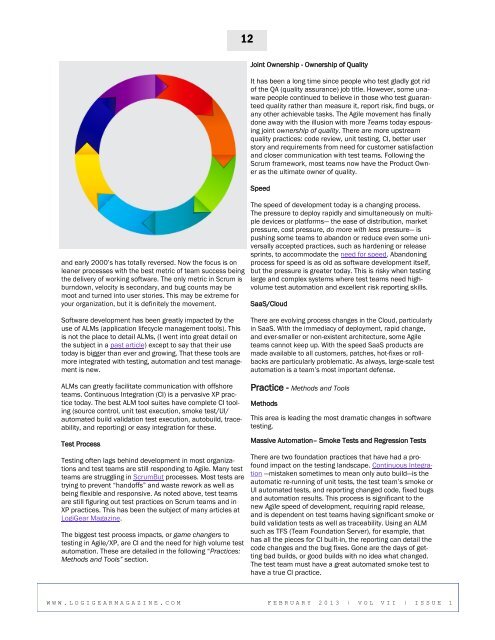LogiGear
February 2013 â The Rapidly Changing Software Testing ... - LogiGear
February 2013 â The Rapidly Changing Software Testing ... - LogiGear
Create successful ePaper yourself
Turn your PDF publications into a flip-book with our unique Google optimized e-Paper software.
12and early 2000’s has totally reversed. Now the focus is onleaner processes with the best metric of team success beingthe delivery of working software. The only metric in Scrum isburndown, velocity is secondary, and bug counts may bemoot and turned into user stories. This may be extreme foryour organization, but it is definitely the movement.Joint Ownership - Ownership of QualityIt has been a long time since people who test gladly got ridof the QA (quality assurance) job title. However, some unawarepeople continued to believe in those who test guaranteedquality rather than measure it, report risk, find bugs, orany other achievable tasks. The Agile movement has finallydone away with the illusion with more Teams today espousingjoint ownership of quality. There are more upstreamquality practices: code review, unit testing, CI, better userstory and requirements from need for customer satisfactionand closer communication with test teams. Following theScrum framework, most teams now have the Product Owneras the ultimate owner of quality.SpeedThe speed of development today is a changing process.The pressure to deploy rapidly and simultaneously on multipledevices or platforms— the ease of distribution, marketpressure, cost pressure, do more with less pressure— ispushing some teams to abandon or reduce even some universallyaccepted practices, such as hardening or releasesprints, to accommodate the need for speed. Abandoningprocess for speed is as old as software development itself,but the pressure is greater today. This is risky when testinglarge and complex systems where test teams need highvolumetest automation and excellent risk reporting skills.SaaS/CloudSoftware development has been greatly impacted by theuse of ALMs (application lifecycle management tools). Thisis not the place to detail ALMs, (I went into great detail onthe subject in a past article) except to say that their usetoday is bigger than ever and growing. That these tools aremore integrated with testing, automation and test managementis new.There are evolving process changes in the Cloud, particularlyin SaaS. With the immediacy of deployment, rapid change,and ever-smaller or non-existent architecture, some Agileteams cannot keep up. With the speed SaaS products aremade available to all customers, patches, hot-fixes or rollbacksare particularly problematic. As always, large-scale testautomation is a team’s most important defense.ALMs can greatly facilitate communication with offshoreteams. Continuous Integration (CI) is a pervasive XP practicetoday. The best ALM tool suites have complete CI tooling(source control, unit test execution, smoke test/UI/automated build validation test execution, autobuild, traceability,and reporting) or easy integration for these.Test ProcessTesting often lags behind development in most organizationsand test teams are still responding to Agile. Many testteams are struggling in ScrumBut processes. Most tests aretrying to prevent ―handoffs‖ and waste rework as well asbeing flexible and responsive. As noted above, test teamsare still figuring out test practices on Scrum teams and inXP practices. This has been the subject of many articles at<strong>LogiGear</strong> Magazine.The biggest test process impacts, or game changers totesting in Agile/XP, are CI and the need for high volume testautomation. These are detailed in the following ―Practices:Methods and Tools” section.Practice - Methods and ToolsMethodsThis area is leading the most dramatic changes in softwaretesting.Massive Automation– Smoke Tests and Regression TestsThere are two foundation practices that have had a profoundimpact on the testing landscape. Continuous Integration—mistaken sometimes to mean only auto build—is theautomatic re-running of unit tests, the test team’s smoke orUI automated tests, and reporting changed code, fixed bugsand automation results. This process is significant to thenew Agile speed of development, requiring rapid release,and is dependent on test teams having significant smoke orbuild validation tests as well as traceability. Using an ALMsuch as TFS (Team Foundation Server), for example, thathas all the pieces for CI built-in, the reporting can detail thecode changes and the bug fixes. Gone are the days of gettingbad builds, or good builds with no idea what changed.The test team must have a great automated smoke test tohave a true CI practice.W W W . L O G I G E A R M A G A Z I N E . C O M F E B R U A R Y 2 0 1 3 ǀ V O L V I I ǀ I S S U E 1





